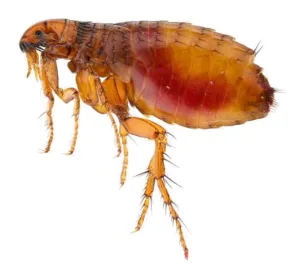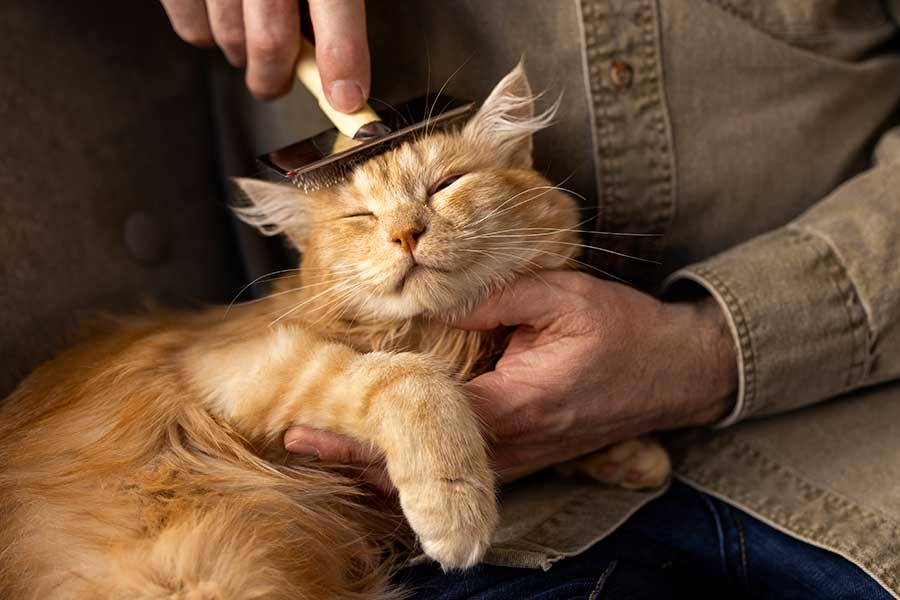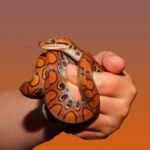Fleas- the notorious tiny pests – are a real annoyance for cats. There are more than 2500 species of fleas and the most common is cat fleas which worry the most to many cat owners. The scientific name of fleas is “Ctenocephalides felis” and they are obligatory hematophagous parasites.
Fleas are adept at hiding within cats’ soft, warm, and moist coats. When in abundance, they become a serious danger to the host (here cats) by transmitting many diseases. According to the American Veterinary Medical Association (AVMA) and the American Society for the Prevention of Cruelty to Animals (ASPCA), fleas can lead to many health issues in cats, from allergic reactions to pernicious anemia.
But don’t worry, you can protect your cat from fleas by learning more about these little insects.
What Do Cat Fleas Look Like?
Most People get confused and can’t identify fleas because of their close similarity with other smaller insects like bed bugs or ticks, for example. Knowing about their size and shape can help you detect cat fleas more aptly.

Fleas on cats are hard to spot due to their small size and color. Their color is Burgundy (additional shads are, dark brown, dark red, and brownish-black). The adult flea size ranges from 1.5 to 3.2 mm long and they are flat from both sides. Cat fleas have sharp teeth with stretched jaws to help them feed from hosts. At the tip of their mouth, they have two sensory points, i.e., nose and antennas to smell and sense to navigate. They have 6 legs which help them crawl and jump on hosts. Four legs on the front are comparatively small and fragile while two rear legs are longer and stronger which fleas use for jumps. The outer body of cat fleas has sharp backward-pointing hairs that aid them in hiding in cats’ fur.
Are Fleas Bad?
Yes, Fleas are sure bad bugs for your cat. Flea bites can cause severe itching and resultant discomfort in cats. Besides, cats may develop allergic reactions to flea saliva, causing dermatitis. Persistent flea infestations can lead to blood loss, causing anemia, particularly in kittens or older cats. In addition, fleas are vectors for several diseases, such as Bartonella (cat scratch fever) and tapeworms, for example. According to the American Veterinary Medical Association (AVMA), keeping an eye out for fleas and acting quickly can protect your cat from fleas and related troubles.
Can My Cat Have Fleas?
Yes, your cat can have fleas even if you don’t see them. Fleas are adept at hiding in the dense coats of cats, making them difficult to spot. These tiny parasites feed on your cat’s blood, causing discomfort, itching, and other health issues. Cat Fleas often go unnoticed in the early stages, as adult fleas comprise only a small percentage of the total population—eggs, larvae, and pupae make up the rest.
Flea eggs can fall off the cat and scatter throughout the environment, such as carpets and bedding. Regular preventive measures, such as flea control products and thorough grooming are important to reduce the chances of flea infestation in your cat. To ensure your cat’s well-being, it is imperative to look beyond the visible and adopt a proactive approach to flea detection, as emphasized by ASPCA.
What Part of Cat Do Fleas Like?
These tiny pests are particularly drawn to specific areas on a cat’s body, with a preference for warm, moist, and sheltered regions. The most common targets include the neck, head, and tail base, according to the experts at AVMA. Fleas with their backward-pointing hairs are good at moving through the thick fur of cats, where they can easily access the cat’s skin to feed on blood. Moreover, fleas may infest the abdominal and groin regions of cats. These areas provide an ideal environment for fleas to feed and reproduce, creating a discomforting cycle for your cat.
Symptoms of Fleas on Cats
Being smaller in size, and due to their innate hiding ability, cat owners can’t easily notice fleas. However, there are some obvious symptoms and signs which can help you determine if your cat has fleas.
- One prominent sign is excessive scratching or grooming, as fleas cause severe itching.
- Cats may exhibit restlessness, constantly biting or licking their fur to alleviate discomfort.
- Skin redness, irritation, and the appearance of small, raised bumps, known as papules, are common dermatological indicators.
- Hair loss, especially around the base of the tail and on the back, may occur due to persistent scratching.
- Flea dirt, resembling small dark specks, may be noticeable in the cat’s fur or bedding, indicating the presence of fleas or feces.
- Cats may develop allergic reactions, leading to more severe symptoms such as inflammation, scabs, and hot spots.
- Flea allergy dermatitis, a common consequence of flea bites, can lead to intense itching and inflammation.
How to Check Cat for Fleas?
According to guidelines from the PetMD and dvm360, regular grooming sessions and preventive measures are essential to a holistic flea-checking routine. To check your cat for fleas, follow these simple steps:
- Observation
• Begin by observing your cat’s behavior. Excessive scratching, biting, or licking are common signs of flea infestation.
• Look for small black or brown specks (flea dirt) on your cat’s fur, which is a clear sign of fleas. - Fur Inspection
• Examine your cat’s fur, especially around the neck, base of the tail, and under the legs. Fleas tend to prefer these warm and hidden areas.
• Use a fine-toothed comb to part the fur and inspect the skin for any signs of fleas or their eggs. - Check for Flea Dirt
• Comb through your cat’s fur and collect any debris on a white paper towel. Moisten the debris with water; if it turns reddish-brown, it is likely flea dirt. - Focus on Hot Spots
• Concentrate on areas where your cat spends the most time, such as bedding, carpets, and furniture. Flea eggs and larvae often accumulate in these areas. - Bite Marks and Redness
• Inspect your cat’s skin for bite marks, redness, or signs of allergic reactions. Flea saliva can cause irritation and allergic dermatitis in some cats. - Use a Flea Comb
• Run a flea comb through your cat’s fur, paying close attention to catching any adult fleas or flea dirt. The comb’s fine teeth can trap fleas and their eggs.
Health Issues in Cats with Fleas
Fleas – the intolerable bloodsuckers- are the most unwanted guests for cats. Not only they are irksome but can also transmit various diseases and allergic reactions in cats. Remember, your cat has all that fleas like; i.e. delicious food (cat’s blood), and an opportunistic environment to grow (warm and moist cat fur). Once inhibited in a cat’s fur, fleas will multiply quickly creating a nuisance for the cat by becoming a carrier for several diseases.
Flea Allergy Dermatitis (FAD)
FAD (Flea Allergy Dermatitis) is an immunologic disease and one primary cause of feline miliary dermatitis. It is the most common fleas-related health problem in cats. This is an inflammatory skin condition that results from an allergic response to flea saliva. Common symptoms of FAD include inflamed skin, unbearable itching, and hair loss which results in infections and open sores.
Tapeworms
Tapeworms in cats result from ingesting infected fleas and or their larvae while self-grooming. In this context, fleas serve as intermediate hosts for tapeworms. These parasites live in the small intestine of cats and can grow up to 2 feet in length.
The most common symptoms of tapeworms in cats include weight loss, scooting, and the presence of small rice-like segments around the cat’s anus. However, tapeworms don’t pose a serious threat to a cat’s health until they are densely populated. So, you don’t need to worry but if you see other symptoms such as vomiting, diarrhea, or signs of anemia, for example, immediately consult your vet for the right treatment.
Flea Anemia
Anemia in cats due to flea infestations is life-threatening. An anemic cat is lethargic, loses appetite and weight, breaths with an open mouth, has whitish gums, and sometimes gets seizures. Other signs can include dark stool and anxiety. Young kittens and older cats are more at risk of getting flea anemia as they have comparatively weak immune systems. Flea-related anemia is particularly concerning when the infestation is severe as fleas consume blood and can cause significant blood loss over time.
Feline Bartonellosis (Cat Scratch Disease)
Feline Bartonellosis is quite irritating for cats. This is an infectious fever condition with other implications due to the bacteria Bartonella henselae. A cat can get this infection from flea bite(s), or other pets. The most common symptoms of Bartonellosis or Cat Scratch Disease commonly referred to as CSD are fever, lethargy, anxiety, swollen lymph nodes, vomiting, and appetite loss. In multi-pet households, the infection can spread rapidly from one animal to another causing a serious risk to the pets’ harmony.
How to Get Rid of Fleas on a Cat?
Fleas are stubborn parasites who reproduce quickly. You won’t notice them until they are everywhere. At this stage, it becomes a bit challenging to get rid of cat fleas. However, preventive measures including proper hygiene, regular grooming, and appropriate pest control approaches can help you get rid of fleas on your cat.
Getting rid of fleas on a cat requires multiple actions simultaneously. As per the AVMA and veterinary professionals, regular grooming sessions are the first and most important step. Using flea combs and employing vet-approved topical treatments are integral components of a complete flea elimination strategy. Begin by regularly grooming the affected cat with a fine-toothed flea comb to physically remove adult fleas and their eggs. Later, bathe the affected cat in a specially formulated flea shampoo. It can further reduce the flea population in the fur.
At the same time, treat the cat’s living environment by vacuuming carpets, upholstery, and bedding regularly to remove flea eggs and larvae. Apply a veterinarian-recommended flea treatment, such as a spot-on solution or oral medication. This is important for killing fleas at various life stages and preventing re-infestation. Remember, choose the products designed specifically for cats, as some ingredients in dog flea treatments can be harmful to cats.
Furthermore, implement preventive measures. This includes using flea collars and keeping the cat indoors to minimize exposure to fleas in the environment. Regularly wash the cat’s bedding and groom other pets in the household. It will help create a comprehensive defense against fleas. Don’t forget to consult with a veterinarian since he will ensure the most suitable and safe flea control plan for the specific cat’s needs, as individual cats may have unique sensitivities or health conditions that need consideration during the flea elimination process.
Can Cat Fleas Transfer to Humans?
Cat fleas (Ctenocephalides felis), primarily love feline hosts. However, they can occasionally bite and feed on humans if their primary host is unavailable. Flea bites on humans may result in red, itchy welts, commonly observed on ankles and lower legs. While cat fleas do not usually establish long-term infestations on humans, they can transmit diseases such as Bartonella henselae, causing fever.
Regular grooming of pets and consulting with a veterinarian for appropriate flea control measures contribute to a healthier coexistence between cats and their human companions. A study cited by the CDC reveals that maintaining good personal hygiene and promptly addressing flea infestations in your cat can minimize the risk of flea bites for humans.
Can an Indoor Cat Get Fleas?
Yes, indoor cats can also get fleas. While outdoor exposure increases the risk, fleas can come indoors via contact with other animals, including outdoor pets or visiting animals. In addition, fleas may transfer on clothing or enter through open doors and windows. Regular preventive measures, such as using vet-recommended topical flea control products and maintaining a clean living environment, are important for safeguarding indoor cats from these stealthy invaders.
Let’s Wrap it Up!
Understanding the signs and implications of flea infestations is vital for cat owners to ensure the health of their feline companions. Fleas pose significant health risks, ranging from allergic reactions to the transmission of diseases. We have highlighted the importance of preventive care, encouraging cat owners to learn about their pets’ behavior and physiology. By broadening our understanding of these external parasites, we can protect our cats from fleas. Prioritizing preventive care and prompt treatment ensures the overall well-being and health of cats, protecting them from the harmful effects of fleas.
Dr. Jawad Ahmed
DVM | Expert in pet behavior
Dr. Jawad Ahmad is a highly skilled DVM with expertise in the intricacies of small pet and large animal behavior. Whether it’s treating sick or injured animals, providing routine check-ups and vaccinations, or offering advice and guidance to animal owners, Dr. Jawad is committed to going above and beyond to ensure the best possible care for animals.
He has experience working with different organizations like the Tahira Animal Welfare Foundation, Todd’s Welfare Organization, and the Poultry Diagnostic Lab. He has more than 20 publications in peer-reviewed journals and achieved 5th position in an international paper competition organized by the University of Brawijaya. His vision is to enlighten and empower pet enthusiasts and animal owners with a profound understanding of proper animal care.










